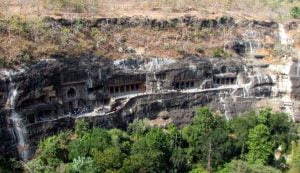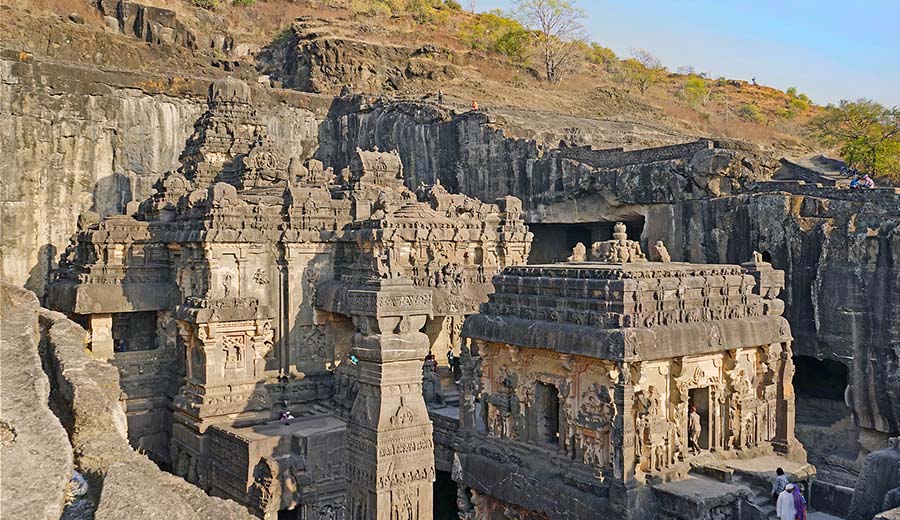Ellora Cave
Know more about Ellora Cave
Ellora cave are a group of Hindu, Buddhist, and Jain shake cut caves additionally situated in the Indian province of Maharashtra close to Mumbai. Not at all like Ajanta caves, these have dependably stayed available to human beings. One of the greatest and the most noteworthy rock temple complexes in the world, Ellora cave is a gathering of temples that were worked between the fifth and the tenth hundred of years AD and furthermore happens to be a World Heritage Site. These temples are extravagantly beautified with paintings and intricate rock carvings that pull in voyagers from around the globe. Ellora caves are extraordinary compared to other examples of rock-cut architecture in India. They are arranged at a distance of roughly 30 km from Aurangabad, a city in Maharashtra. The caves speak to one of the biggest rock-cut monastic-temple complexes in the world.
Number of Caves in the Ellora group
There are 34, out of which 12 are Buddhist caves, 17 are Hindu and 5 are Jain caves. A portion of the Hindu caves has been built at the soonest when contrasted with different groups.
Architectural features and Ornamentation-
The striking features of these caves incorporate a 15 meters tall statue of Lord Buddha. This statue is arranged in give in number ten which is there in the Buddhist group of caves. Likewise, one all the more architecturally praised highlights is the Kailasanatha temple which is there in the Hindu group of caves. This temple was removed from an awesome stone and was at some point secured with white mortar to impeccably look like Mount Kailash-the home of Lord Shiva. Take in more about Ajanta and Ellora Cave Paintings. These caves were pronounced a World Heritage Site in 1983 when the first round of acknowledgment was finished by UNESCO in India.
Interesting and Fun Facts About Ellora Caves
- Ellora caves are privately known as ‘Verul Leni’.
- The Great Kailasa (Cave 16) at Ellora gloats of being the biggest single solid exhuming in the world.
- The caves are datable from around the sixth seventh century A.D. to the eleventh twelfth century AD.
- The slopes that have filled in as the setting of Ellora caves frame a piece of the Sahyadri scopes of the Deccan. These extents go back to the Cretaceous time of the Geological time scale (around 65 million years prior).
- There is inscriptional prove identified with Rashtrakuta Dynasty, on the back mass of the front mandapa of Cave 15.
- The most punctual Buddhist cave will be Cave 6, which was built between 630-700.
- The Great Kailasa (Cave 16) is credited to Krishna I (c. 757-83 A.D.), the successor and uncle of Rashtrakuta Dantidurga.
- Caves 1 to 10 and Cave 21 (Ramesvara) are for the most part credited to the Kalachuris of Mahismati.
- Brahmanical caves and two Buddhists (caves 11 and 12) are credited to the Rashtrakuta times.
- Ellora caves are open from dawn to dusk all days of the week, with the exception of, Tuesday.
- The Great Kailasa is a freestanding, multi-storied temple perplexing, worked to take after Mount Kailasa – the homestead of Lord Shiva.
- Dashavatara (Cave 15) at Ellora delineates the ten avatars of Lord Vishnu.
- The passage of Ramesvara (Cave 21) is enhanced with figurines of River Goddesses – Ganga and Yamuna.
- The plan of Dhumar Lena (Cave 29) is like the cave temple on Elephanta Island, close to Mumbai.
- Buddhist caves for the most part comprise viharas or cloisters, which include living quarters, sleeping quarters, kitchens, and other rooms.
- Vishwakarma cave (Buddhist cave 10) is otherwise called “Woodworker’s Cave” and houses a 15-foot statue of Buddha, situated in a preaching posture.
- Among every Buddhist cave, the initial nine (caves 1-9) are cloisters, while the last two – Do Tal (cave 11) and Tin Tal (cave 12) have three stories.
- The Jain caves at Ellora stand are decorated with uncommonly definite craftsmanship and rich paintings on the dividers and the ceilings; some of which are as yet unmistakable.
- Chhota Kailash (cave 30), Indra Sabha (cave 32), and Jagannath Sabha (cave 33) are the most exceptional Jain caves.
- Ellora cave, in combination with Ajanta caves, has been pronounced a UNESCO World Heritage Site.
The Hindu caves were built during the Kalachuri period from the sixth century to the finish of the eighth century. The vast majority of these temples contained sacred writings and divider carvings depicting the wedding customs of Goddess Parvati and Lord Shiva.
Places to visit around Ellora Cave
Ajanta Caves:

The Ajanta Caves are a series of 30 rock-cut Buddhist cave temples located about 100 km from Ellora Cave. These caves date back to the 2nd century BCE and are renowned for their magnificent wall paintings and sculptures. The caves depict scenes from the life of the Buddha and the Jataka tales, showcasing the skill and artistry of ancient Indian artists. A visit to the Ajanta Caves is a must for anyone interested in the rich cultural heritage of India.
Grishneshwar Temple:
Grishneshwar Temple is a Hindu temple dedicated to Lord Shiva, located just 2 km from Ellora Cave. This temple is one of the 12 Jyotirlinga shrines in India and is considered to be a sacred site by Hindu devotees. The temple features intricate carvings and sculptures and is known for its beautiful architecture and peaceful atmosphere. Visitors to the temple can offer prayers and seek blessings from Lord Shiva.
Daulatabad Fort:
Daulatabad Fort is a well-preserved medieval fort located about 13 km from Aurangabad. This fort was built in the 12th century and was once the capital of the Deccan plateau. The fort features several temples, palaces, and water tanks, and is surrounded by a moat. Visitors to the fort can explore its many historic monuments and learn about the rich history and culture of the region.
Bibi Ka Maqbara:
Bibi Ka Maqbara is a mausoleum located in Aurangabad, often referred to as the “Taj of the Deccan.” This mausoleum was built in the 17th century in memory of Aurangzeb’s wife and is a fine example of Mughal architecture. The mausoleum features intricate carvings and a large central dome and is set amidst beautiful gardens. Visitors to Bibi Ka Maqbara can admire its stunning architecture and learn about the rich history of the Mughal Empire.
Pithalkora Caves:
The Pithalkora Caves are a series of ancient rock-cut cave sites located about 60 km from Aurangabad. These caves date back to the 2nd century BCE and feature Buddhist rock-cut temples and chaitya halls. The caves are known for their intricate carvings and sculptures and offer a glimpse into the rich cultural heritage of ancient India. A visit to the Pithalkora Caves is a must for anyone interested in Indian history and archaeology.
Aurangabad Caves:
The Aurangabad Caves are a group of rock-cut Buddhist caves located in Aurangabad. These caves date back to the 6th and 7th centuries CE and feature intricate carvings and sculptures depicting scenes from the life of the Buddha. The caves are a testament to the skill and artistry of ancient Indian artists and offer a glimpse into the rich cultural heritage of the region. A visit to the Aurangabad Caves is a must for anyone interested in the history and culture of India.
How to reach Ellora Cave
Ellora Cave is located in Aurangabad, Maharashtra, India, and can be reached by several modes of transportation:
- By Air: Aurangabad Airport is the nearest airport to Ellora Cave and is well-connected to major cities in India such as Mumbai and Delhi. From the airport, you can take a taxi or an auto-rickshaw to reach Ellora Cave, which is about 30 km away.
- By Train: Aurangabad Railway Station is the nearest railway station to Ellora Cave and is well connected to major cities in India such as Mumbai, Delhi, and Pune. From the railway station, you can take a taxi or an auto-rickshaw to reach Ellora Cave, which is about 6 km away.
- By Road: Ellora Cave is well connected by road and can be reached by private or public transport. Aurangabad is well connected to other major cities in Maharashtra by road and there are several state-run and private buses that run regularly to and from the city. You can also hire a taxi or an auto-rickshaw to reach Ellora Cave.
It is advisable to check the latest travel guidelines and restrictions due to the ongoing COVID-19 pandemic before planning your visit to Ellora Cave.
Best time to visit
The best time to visit Ellora Cave in Aurangabad, Maharashtra, India is from October to March, during the winter months. During this time, the weather is pleasant and comfortable for sightseeing and exploring the caves. Temperatures range from 10-25°C during this time, making it ideal for outdoor activities.
The summer months from April to June can be quite hot, with temperatures reaching up to 40°C. The monsoon season from July to September can be unpredictable, with heavy rainfall and slippery roads.
Overall, the winter months offer the best weather for a visit to Ellora Cave, allowing visitors to explore the caves comfortably and take in the beauty of the site without being hindered by extreme temperatures.



